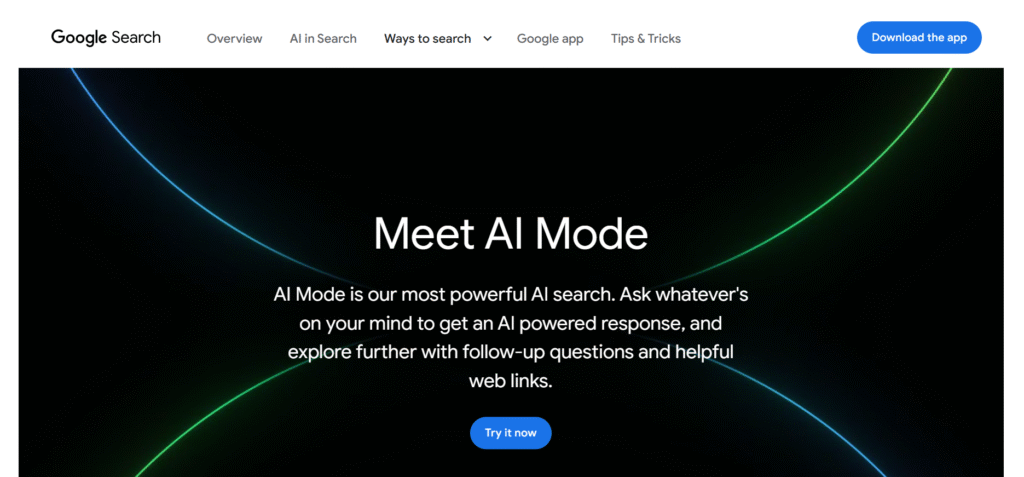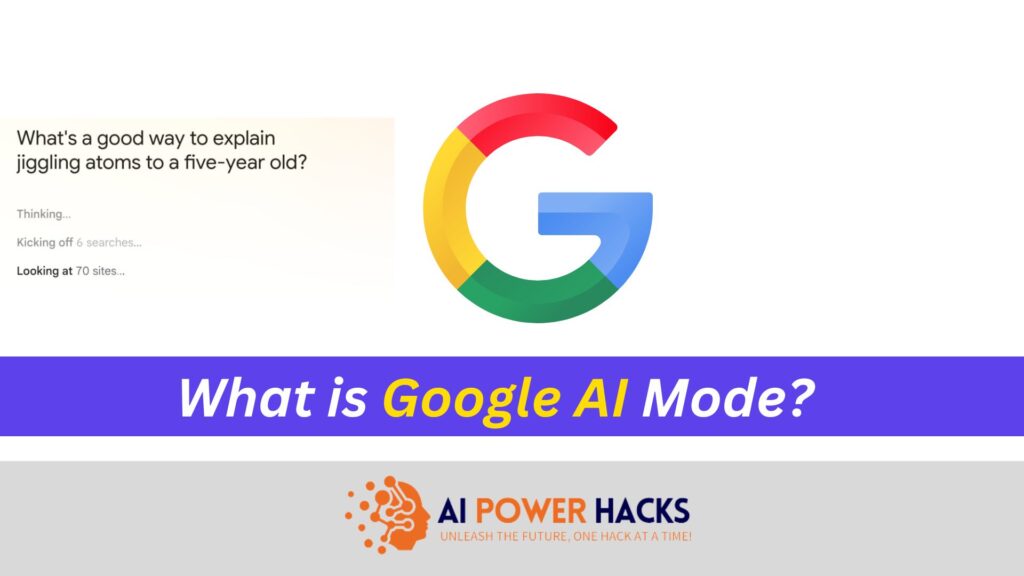In the fast-evolving world of search technology, Google has introduced something groundbreaking: Google AI Mode. This cutting-edge feature is transforming how users interact with search, delivering conversational, AI-generated answers instead of just a list of blue links. In this post, you’ll discover what Google AI Mode is, how it works, why it matters for SEO, and how content creators can optimize for it today—and in the near future.
1. Say Hello to Google AI Mode — Search with a Brain
Google AI Mode isn’t your traditional search experience. Rather than scanning search engine results pages (SERPs), it provides full, conversational answers directly at the top of search results. Whether you’re typing, speaking, or uploading a photo—AI Mode tackles it all. Its flexibility makes searching feel intuitive, whether you’re on mobile or desktop.
2. How Does Google AI Mode Work?
Multimodal Inputs
AI Mode supports various input types: text, voice, photos, or uploads. By understanding the input context, it delivers relevant answers seamlessly.
Query Fan-Out
Behind the scenes, your question is split into multiple sub-queries—each exploring a different angle. For example, if you ask, “best credit card for travel,” AI Mode may probe fees, perks, user reviews, and more, in parallel.
Passage-Level Retrieval
Instead of ranking full pages, AI Mode retrieves specific sections—paragraphs, sentences, or lists—that address parts of your query. Even content buried deep in a page may surface if it answers the user’s intent clearly.
Conversational Follow-Ups
AI Mode keeps context. You can ask follow-up questions like, “compare destinations in Canada” or “check visa requirements,” and AI Mode responds conversationally—no need to start anew.
3. What’s New in 2025? Agentic and Personalized AI Mode
As of August 21, 2025, Google significantly expanded AI Mode’s capabilities. Key enhancements include:
- Agentic capabilities: AI Mode can now perform tasks for you, such as booking restaurant reservations based on preferences like party size, time, cuisine, and location—then provide direct booking links.
- Personalized recommendations: The system can tailor suggestions using your past preferences and search behavior—suggesting restaurants based on diet preferences, past likes, or seating preferences.
- Global reach: AI Mode is now available in over 180 countries and territories in English, expanding beyond the U.S., India, and the U.K.
- Link sharing: You can now share AI Mode responses so others can explore and ask follow-ups interactively.
These agentic and personalized features mark AI Mode’s shift from being informational to truly assistive.

4. Why Google AI Mode Matters to SEO
The rise of AI Mode signals a seismic shift in SEO. Here’s why:
From Page to Passage
Since AI Mode fetches passages—not entire pages—SEO must focus on making even small content chunks crystal clear and precise.
Structured and Scannable Content Wins
AI Mode favors content that’s structured with clear headings, bullet points, FAQs, and concise sections. Proper formatting increases your content’s chance of being selected.
Intent Matching Is Essential
It’s no longer enough to rank for keywords. Content must directly align with user intent and phrasing variations, because AI Mode stitches information based on meaning—not just word match.
Early Mover Advantage
Brands that adapt early to this new search paradigm by focusing on clarity, relevance, and structure could gain a real edge in emerging AI-driven SERP formats.
5. Preparing for Google’s Broader AI Features
Beyond AI Mode, Google also offers AI Overviews, which appear as summarized answers at the top of regular search results. To optimize for these:
- Create high-quality, comprehensive content that thoroughly answers user questions.
- Use structured data and schema markup to help Google understand and extract your content accurately.
- Make content scannable using headings, bullet lists, and FAQs.
- Leverage Yoast SEO tools, including readability checks, internal linking, and schema markup features.
- Monitor metrics via Google Search Console, including AI Overview impressions and interactions.
6. SEO Best Practices for AI Mode-Ready Content
Here’s a quick optimization checklist:
- Craft structured content
Use clear headings, bullet points, FAQs, and short paragraphs to enhance scannability. - Align with user intent
Analyze your audience’s questions and ensure your content directly addresses them—preferably in multiple phrasings. - Write focused passages
Break content into standalone, answerable chunks that AI Mode can extract effectively. - Add schema markup
Use structured data (via Yoast or manually) so Google can better interpret and present your content. - Use AI tools smartly
Generate title/meta suggestions with Yoast AI Generate—and refine them for clarity and engagement. - Review with human expertise
Always vet AI outputs for accuracy, tone, and branding consistency. - Monitor and adapt
Watch the performance of AI-driven snippets and SERP appearances in Search Console to refine your approach.
7. The Future of Search and Content Strategy
Google AI Mode is emerging as the future of search. With agentic features and personalized AI becoming more widespread, content that’s contextually clear, user-friendly, and structured will perform better in AI-driven search formats.
Long-form, keyword-stuffed pages may no longer suffice—instead, concise, modular, intent-aligned content has the edge. Brands that embrace this shift early stand to reap lasting SEO rewards.
Conclusion
Google AI Mode is revolutionizing search. By offering conversational, AI-powered responses—and now even acting on user’s behalf—Google is redefining what search visibility means. For website owners and content creators, the key is to make content structurally clear, intent-aligned, and easy for AI Mode to extract and present.
By leveraging AI features, optimizing for passage-level visibility, and aligning with evolving search behaviors, you’ll be well-positioned to rank—and shine—in this new AI-powered search landscape.


